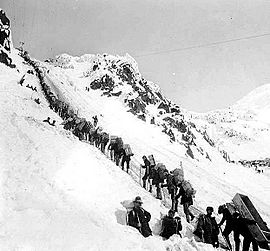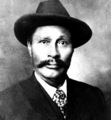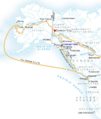Klondike Gold Rush facts for kids
Quick facts for kids Klondike Gold Rush |
|
|---|---|

Gold seekers climbing the Chilkoot Pass, 1898
|
|
| Other names | Alaska Gold Rush, Yukon Gold Rush |
| Main Location | Dawson City at Klondike River, Yukon, Canada |
| When it happened | 1896–99 (main rush: 1897–98) |
| Gold Found | August 16, 1896, Bonanza Creek |
| Discoverers | George Carmack and Skookum Jim |
| People who went | 100,000 tried, 30,000 arrived |
| Main Paths | Dyea/Skagway route and others |
The Klondike Gold Rush was a huge movement of people looking for gold. Around 100,000 gold seekers traveled to the Klondike region in the Yukon, north-western Canada. This happened between 1896 and 1899.
Local miners found gold on August 16, 1896. When news reached cities like Seattle and San Francisco the next year, it caused a "stampede." Many people rushed to the Klondike hoping to get rich. Some did find wealth, but most did not. This exciting time is remembered in photos, books, movies, and old items.
Contents
Journey to the Gold Fields
To reach the gold areas, most people traveled through ports in Southeast Alaska. These ports were Dyea and Skagway. From there, the gold seekers, called Klondikers, followed tough trails. The two main trails were the Chilkoot and the White Pass. These trails led to the Yukon River. Once at the river, they could sail down to the Klondike region.
Tough Rules for Travelers
The Canadian government made a rule to prevent people from starving. Each person had to bring a year's worth of food and supplies. All their gear weighed almost a ton. Most people had to carry these heavy loads themselves, bit by bit.
The journey was very hard because of the mountains and the cold weather. Many people who kept going did not arrive until the summer of 1898. Once they got there, they often found few chances to strike it rich. Many left feeling disappointed.
Mining Challenges
Finding gold was difficult because the gold was not spread evenly. Digging was also slow due to permafrost, which is ground that is always frozen. Because of these challenges, some miners decided to buy and sell mining claims. They would invest a lot of money and let others do the hard work of digging.
Rise of Boom Towns
To support all the gold seekers, new towns quickly appeared along the travel routes. At the end of the journey, Dawson City was founded. This town was built where the Klondike River meets the Yukon River.
In 1896, Dawson City had only about 500 people. By the summer of 1898, it grew to about 30,000 people. The town was built mostly of wood and was far away from other places. It also had poor sanitation. Dawson suffered from fires, very high prices for goods, and sicknesses.
Despite these problems, the richest gold seekers spent their money freely. They enjoyed themselves in the town's saloons. However, the local Hän people suffered greatly from the gold rush. They were moved to a special area called a reserve to make room for the new arrivals. Many faced hardship during this time.
End of the Gold Rush
Starting in 1898, newspapers that had encouraged so many people to go to the Klondike began to lose interest. In the summer of 1899, new gold was found near Nome in western Alaska. Many gold seekers left the Klondike to go to these new goldfields. This marked the end of the Klondike Gold Rush.
The boom towns that had grown so fast began to shrink. The number of people living in Dawson City also dropped.
Gold mining continued in the Klondike until 1903. Production was highest after heavier equipment was brought in. Since then, gold has been mined in the Klondike on and off. Today, the history of the gold rush brings tourists to the area. This helps the region's economy. It is estimated that about 14 million ounces of gold have been taken from the area over time.
Images for kids
-
Skookum Jim, one of the discoverers, 1898
-
Routes to the Klondike (red spot). For details see appendix.
-
Prospectors in a tent camp at Bennett Lake waiting for the ice on Yukon River to break up, May 1898.
-
Klondikers sailing toward Dawson on the upper Yukon River, 1898.
-
A tent-camp along the Pelly River a Canadian tributary to the Yukon River, 1898.
-
Yukon River with Klondike City (foreground) and Dawson City (upper right), 1899
-
People leaving Dawson City, Yukon for Nome, Alaska September 1899
-
Skagway with cruise ships, 2009
-
Charlie Chaplin in The Gold Rush, 1925
See also
 In Spanish: Fiebre del oro de Klondike para niños
In Spanish: Fiebre del oro de Klondike para niños






























